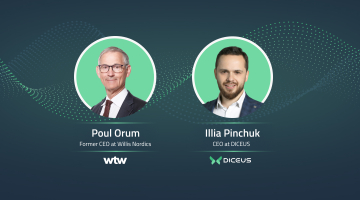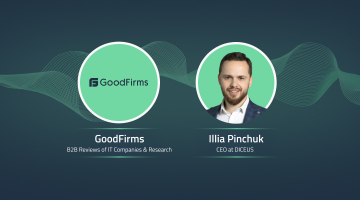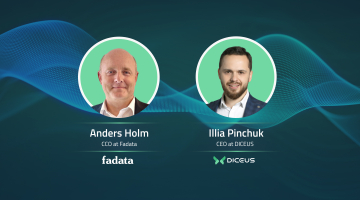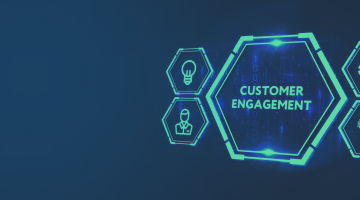
Part 1: Interview with the CEO of UNIVERSALNA — Digitalization is the future of insurance companies
The DICEUS team is happy to share an interview with Oleksii Muzychko, CEO of UNIVERSALNA Insurance Company, which is a part of the Fairfax group of companies. Our CEO Illia Pinchuk talked with Oleksii about the difference between “online” and “digital” capabilities provided by insurance companies, the benefits of digital channels for insurers and their clients, and the challenges of implementing digital products.
Oleksii started his career as a lawyer at “Lviv Airlines” and succeeded in the insurance sector working in UNIQA for many years. Today, Oleksii runs UNIVERSALNA and strives to lead the company to successful insurance businesses driven by digital technologies.
Q: Oleksii, insurers pay a lot of attention to effective interaction with end buyers and use new technologies for that. Do you agree that digital channels, which are mobile apps or chatbots, where users can calculate the cost of insurance, pay and get a policy, and make an appointment with a doctor, will continue to be adopted by insurance companies?
A: Of course, this is the future. We see that such apps as “Diia” or “Mono Bank” are successful. However, here’s an interesting discussion. What do we mean by “digital”? Sometimes people understand it as everything that’s online. Yes, any digital is online, but not any online is digital, right? For example, we have been making online regulations for a long time. Our clients are not obliged to go anywhere to the office. They can take a photo of a damaged car online, fill out the documents, and send them. We automatically send them either to the service station or make a payment, and it all happens online. They can also buy the policy on the website. It’s online but not digital.
Digital is taking photos of your vehicle. The program automatically calculates the cost of this damage, communicates with the client, and sends them to a service station without using the human factor. Digital is when you submit a claim online via a mobile app or chatbot. And the program automatically accesses the database. For example, a realtor calculates the average cost of a house you’d like to insure, depending on its location, seismic or flood zone. That’s digital, right?
For insurance, it is more difficult to become digital than for the banking system because there is a concept of underwriting in insurance. Underwriting depends not only on user behavior. There are financial models and scoring systems. It still depends on many other factors: territory, weather, etc.
Q: What are the biggest advantages of digital channels from the customer’s perspective?
A: Customers want to spend as little time choosing a company and coverage conditions as possible. Clients usually want to do some simple, clear things on their phones. The things that give clients comfort are a) they don’t overpay, b) they get quality service, and c) they get it quickly. In case of an insured event, the client has no problem opening the app and taking simple actions when convenient. So, the fewer actions people need to take, the easier it is for them, and the more successful the interaction model will be.
Q: How can digital channels make the work of insurance companies more efficient? Perhaps, there will be no physical offices in the future?
A: I don’t believe there won’t be brick-and-mortar offices because there are still partner sales, legal entities, and non-standard risks. For example, you cannot work digitally with a vast enterprise on health insurance. Specialists should do it anyway. They must go there, explain and talk about programs.
As for retail, there will be no classical offices of insurance companies. In our company, they are almost gone. They were moved to online and digital affiliate programs and sales.
In the case of highly qualified sellers and underwriters, who can sell a more complex product for large teams and enterprises and establish interaction with partners, such as car dealership chains or banks, no digital could replace it. In the case of physical clients – indeed, this is already happening. And this is a significant reduction in the costs of the insurance company.
Q: Can the transition to online and digitalization affect the tariff by reducing the insurance company’s costs?
A: Definitely, the tariff will be easier to count for underwriters because the information you receive through digital channels is structured. And it will be easier to do underwriting.
What is insurance? It is a joint responsibility with elements of individualization. That is, you have 100 insured. Let’s say they all insured the cars. 30% will commit accidents; the rest will not, but everyone pays. Due to the calculated tariff, the insurance company remains with small profits because the tariff policy will not allow for making a big profit. The company will be uncompetitive.
If the year is successful, say, with good weather conditions and many other factors affecting the insurance company, then these channels allow you to get more structured information from the very beginning and make it possible to establish a fairer tariff. I wouldn’t say “lower” tariffs. I would say a fairer tariff.
The share of the expenses in a net tariff during digitalization will decrease because fewer admins will work as no offices are needed in the city center, for instance. You don’t need so many sellers who will issue policies in the office because it will be done online. Of course, this will decrease the share of administrative costs in the tariff structure.
Moreover, it allows for making the tariff individual. For example, “pay as you drive” or “pay how you drive.” You may already have some individual offers depending on how much, how, and where you drive. By the way, we had such a project, and I will tell you about it further.
Q: How quickly will insurance companies use digital channels so that all functions are automated as much as possible?
A: It depends on the insurance market. For example, in Ukraine, the main sales channels are affiliate sales. If we are talking about Kasko, these are networks of car dealerships, banks, and leasing companies. And if we are talking about voluntary health insurance, these are large enterprises because individual insurance is not developed yet, unfortunately.
Along these lines, digital is only a service for the client; it is a convenience. Any average insurance company has either a bot or a mobile app that helps clients report a case, make an appointment with a doctor and get an address to pick up medicines. These are service functions that simplify the process but not the sales features.
As a rule, if you work with car dealerships or leasing companies, people want a standard contract that covers everything. And there is no digital. There are partnerships. Accordingly, the greater the share of such insurance, the less digitalization is needed. For example, a man buys a car at a car dealership and can buy a policy there. Unfortunately, we do not have online car registration. Perhaps, we’ll need a digital channel if there is an online registration of vehicles.
On the other hand, we have a retail product Kasko that is a must. We have a market with a certain number of consumers. Here, we see the flourishing of technology, both online and digital. Formally, the first electronic policy, which was legally registered, was made in third-party motor liability. So, the more customers choose insurance individually, the greater the development of digitalization. In partner channels like banks, car dealerships, and leasing companies, there will be more attention to the service part. Therefore, it all depends on how the market is built.
Q: Is your company moving in the direction of digitalization? What projects did you implement? I know there’s some kind of telemetry project.
A: Before talking about telemetry, I’d like to say that our company switched to a decentralized management model of the company before COVID. Many people didn’t want to waste their time on the way to the office. Thus, we are free to have a flexible working schedule.
We got into COVID very smoothly, and, unfortunately, we entered the war times smoothly. That is a challenge that I did not want to experience. But we have effectively coped in managing the company and providing customer service.
Then, we said, “Listen, guys, and if we do this for our employees, why don’t we do it for our customers? Why do we still require our customers to fill out papers, come somewhere, and show something? Why don’t we do it online?” And we began to offer online services to avoid using much physical presence. First in regulations, medical assistance, and then in sales.
Secondly, we had partners who offered us an exciting product based on the “pay how you drive” principle. It is Kasko insurance based on how and where you drive. The technology is called telemetry, which means you put some device in your car to read specific indicators. Based on how you drive, you can have an individual tariff. We offered a mobile app: you get into the car, open a mobile app, and it reads the information on how you drive.
But customers don’t want to interact with the insurance company, send some data, turn on the mobile phone every time when sitting in the car, and take pictures of some mileage. It’s like simple things, but they create additional inconvenience for the client.
However, we were interested in ways to individualize the tariff from the perspective of underwriting. How accurate is this concept of individual calculation of factors? How and where do you drive, and at what speed and frequency? You can be an ideal driver, but driving on those routes with a high accident rate will automatically increase the cost of insurance. We were interested in testing how it works. And from that point of view, it was a very successful product because we got lots of knowledge. It was a test product where we could work out interaction with a mobile app and our databases and get proof of the concept of individual underwriting in mass-market products.
Q: Is it challenging to implement such projects? How long did it take for the project to go live?
A: Hard. Many factors include how much you and your partner are ready to allocate resources. If you change the system, you assign all possible resources. If you make an app with no commercial potential but is interesting for you, you allocate those resources you can. Speaking about the time, it took many months. Also, you can’t say that when you launched the product, that’s it. You are constantly changing the design, adding some options, and optimizing it. Supporting such a project is constant work.
Q: I heard about another project, Vitaminise, a chatbot you plan to use for sales and reimbursement of car insurance. What is the goal of this project?
A: The goal is to go into retail as much as possible and get more customers. We are now talking about free retail. A young, ambitious team came to us, offering cooperation to start active online and digital sales in the retail market.
Why is this interesting? Because we can invest long-term resources. And I liked the concept itself because this is the approach I tolerate – the client’s needs and the solutions’ simplicity. We jointly understand the direction. Now we have to launch a chatbot on car insurance.
Q: Is it possible to transfer the experience of these two projects related to car insurance to other products? I mean, health or travel, etc.
A: Travel is the next step because it is a very easy product to digitalize. It is accessible from the point of view of underwriting and does not require complex applications. Regarding health insurance — to a certain extent. This is about some simple products from the point of view of medicine. For example, covering ambulances, hospital expenses, etc. And I think our customers will also need such products.
Q: What types of insurance are the easiest to implement new technologies for?
A: Firstly, these are those products that do not require complex underwriting. What do we mean by underwriting? This is an assessment of risks. I have already named them — travel, accident, etc.
Secondly, these are the products where insurance payment with money is normal. Kasko, for example, you take photos, and the system calculates the compensation online, with no human factor. You receive an offer that a certain amount will be paid within an hour. It works. But the question is, what do you do next with your car? You get the money and repair the car, but you get a different price for repair work.
Another example is property and casualty insurance. Imagine you were flooded with a neighbor. You took photos, and artificial intelligence estimated the average cost of your repair and decoration and offered some reimbursement for you. It’s convenient as you don’t have to collect a bunch of documents. But the question arises, “I decided to restore it, and this is not the amount the insurance company paid me.”
There are many nuances here. First of all, it depends on the behavioral pattern of clients. Some clients understand that they can’t get a full refund of what was lost because everyone has a different vision for it, but they can get it quickly. These are our customers. They need to be attracted because they are in the digital channel.
Q: Are you focused on any other innovative technologies?
A: We are working a lot with voluntary medical insurance services. This is not a digital channel, but a lot of benefits have to be provided to customers, both to individual consumers and brokers. We put a lot of effort there to make it as comfortable as possible for our partners, customers, and the insured. We invest a lot in car insurance in terms of settlement to further simplify this procedure for both the client and us. Of course, now the situation of hostilities in which we find ourselves is slightly adjusting the plans. We probably don’t want to start new projects until the war ends. But those projects that are already in the process are moving. We must develop, regardless of the situation.
Q: What advice would you give to those heads of insurance companies who would like to follow the digital path?
A: I would advise focusing on the client’s needs and doing it as simply as possible. Simplicity, simple logic, and solutions. Less functionality, but functionality users need. Let the design be more straightforward, but this will be precisely what the client needs.
Read Part 2 of the interview.





